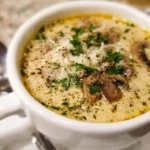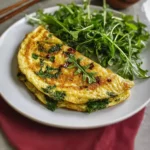The Cobb Salad has become a staple in our household, and let me tell you, it’s not just another salad – it’s a meal experience. From busy weeknights to relaxed weekend lunches, this recipe has consistently delivered a symphony of flavors and textures that even the pickiest eaters in my family adore. What I love most is its versatility; you can easily tweak it based on what you have on hand or your family’s preferences. Initially, I was a bit intimidated by the ingredient list, thinking it was too much work for a salad. But once I broke it down and prepped the components, I realized how surprisingly simple and satisfying it is. The vibrant colors and the satisfying crunch of each bite make it a true delight, and it’s become a go-to whenever we crave something healthy yet undeniably delicious. Trust me, once you master this recipe, the Cobb Salad will earn a permanent spot in your culinary repertoire, just like it has in ours.
Ingredients
The beauty of the Cobb Salad lies in its meticulously curated ingredients, each playing a crucial role in the overall flavor and textural profile. While the classic recipe is quite specific, don’t be afraid to consider high-quality substitutions if needed, while always aiming for the freshest components possible for the best results. Here’s a comprehensive breakdown of what you’ll need to create a truly exceptional Cobb Salad:
- Lettuce Base (Approximately 1 head, or 6-8 cups chopped): A blend of lettuces is traditional and highly recommended for a diverse flavor and texture.
- Romaine Lettuce: Provides a crisp, sturdy base with a slightly bitter and refreshing taste. It holds up well to the weight of the toppings and dressings. Look for firm, bright green heads.
- Iceberg Lettuce: Offers a mild, watery crunch that contrasts nicely with the richer ingredients. Its delicate flavor doesn’t overpower the other components. Choose heads that are tightly packed and firm.
- Butter Lettuce (Boston Lettuce or Bibb Lettuce): Adds a softer, more delicate texture and a slightly sweet, buttery flavor. Its tender leaves provide a lovely contrast to the crunchier lettuces. Select heads with vibrant, undamaged leaves.
- Optional Lettuce Variations: Consider adding a touch of red leaf lettuce for color or green leaf lettuce for a milder flavor. Spinach can also be incorporated for added nutrients, although it’s less traditional.
- Cooked Chicken Breast (Approximately 2-3 breasts, about 1.5-2 cups shredded or diced): Chicken is the primary protein source, adding substance and savory flavor.
- Preparation Methods: Grilled, roasted, poached, or even leftover rotisserie chicken all work wonderfully. Grilling and roasting impart a smoky, deeper flavor, while poaching results in incredibly tender and juicy chicken. Rotisserie chicken is a fantastic time-saver.
- Seasoning: Ensure your chicken is well-seasoned. Simple salt and pepper are essential, but consider adding garlic powder, onion powder, paprika, or herbs like thyme or rosemary for extra depth. Marinating the chicken before cooking can also significantly enhance its flavor.
- Quality Matters: Opt for high-quality, boneless, skinless chicken breasts. Organic or free-range chicken will often yield better flavor and texture.
- Crispy Cooked Bacon (Approximately 6-8 slices, about 1 cup crumbled): Bacon provides that irresistible smoky, salty, and crispy element that is quintessential to a Cobb Salad.
- Type of Bacon: Regular-cut bacon is ideal. Thick-cut bacon can be used, but ensure it cooks thoroughly to crispness.
- Cooking Methods: Pan-frying, baking in the oven, or even microwaving bacon between paper towels are all effective methods. For oven baking (around 400°F/200°C for 15-20 minutes), place bacon on a baking sheet lined with parchment paper for easy cleanup. Microwaving is the quickest method for a few slices.
- Crispiness is Key: The bacon should be thoroughly cooked and crisp. Avoid undercooked, chewy bacon. Drain excess grease after cooking to maintain crispness.
- Hard-Boiled Eggs (3-4 large eggs, peeled and quartered or chopped): Eggs contribute creamy richness and protein, adding another layer of texture and flavor complexity.
- Perfect Hard-Boiled Eggs: Place eggs in a saucepan and cover with cold water by about an inch. Bring to a rolling boil, then remove from heat, cover, and let stand for 10-12 minutes for large eggs (adjust time for size). Immediately transfer to an ice bath to stop cooking and make peeling easier.
- Chopping Style: Quartering or chopping depends on your preference. Quartered eggs offer a more visually appealing presentation, while chopped eggs distribute more evenly throughout the salad.
- Avocado (1-2 ripe avocados, diced or sliced): Avocado adds creamy richness and healthy fats, complementing the other ingredients beautifully.
- Ripeness Check: Avocado should be slightly soft to the touch but not mushy. If it yields easily to gentle pressure, it’s ripe. Avoid avocados that are overly soft or have dark spots.
- Preparation: Cut avocado in half, remove the pit, and dice or slice the flesh. To prevent browning, toss diced avocado with a little lemon or lime juice.
- Variety: Hass avocados are most commonly available and have a rich, nutty flavor.
- Blue Cheese (Approximately ½ cup, crumbled): Blue cheese provides a pungent, salty, and creamy counterpoint to the other flavors.
- Type of Blue Cheese: Roquefort, Gorgonzola, or Stilton are classic choices. Roquefort is sharper and saltier, Gorgonzola is milder and creamier, and Stilton is rich and complex. Choose based on your preference for intensity.
- Crumbling: Crumble the blue cheese into small, manageable pieces. Avoid large chunks that might be overpowering.
- Alternatives (for those who dislike blue cheese): Feta cheese (salty and tangy), goat cheese (creamy and slightly tart), or sharp cheddar cheese (more familiar and milder) can be used as substitutes, though they will alter the classic Cobb flavor profile.
- Tomatoes (1-2 medium tomatoes, diced or chopped): Tomatoes add freshness, acidity, and a juicy burst of flavor.
- Type of Tomatoes: Roma tomatoes, cherry tomatoes (halved or quartered), or heirloom tomatoes all work well. Choose ripe, flavorful tomatoes for the best taste.
- Preparation: Dice or chop tomatoes into bite-sized pieces. Remove seeds if desired to reduce excess moisture in the salad.
- Cucumber (½ cucumber, peeled and diced or sliced): Cucumber provides a cool, refreshing crunch and mild flavor.
- Type of Cucumber: English cucumbers (also known as seedless cucumbers) are preferred as they have fewer seeds and a thinner skin. Regular cucumbers work too, but you may want to peel and remove some of the seeds.
- Preparation: Peel (optional, especially for English cucumbers), and dice or slice cucumber. Dicing provides a more uniform texture in the salad.
- Green Onions or Chives (2-3 green onions or a small bunch of chives, thinly sliced): Green onions or chives add a mild oniony bite and fresh, herbaceous flavor.
- Preparation: Thinly slice green onions, using both the white and green parts. Chives can be snipped with kitchen shears or chopped finely.
- Alternatives: If you don’t have green onions or chives, a very small amount of finely minced red onion can be used, but use sparingly as red onion is much stronger in flavor.
- Cobb Salad Dressing (Classic Vinaigrette or Creamy Ranch): The dressing ties all the ingredients together and adds a crucial layer of flavor.
- Classic Vinaigrette: A traditional Cobb Salad dressing is a red wine vinaigrette. A simple vinaigrette can be made with red wine vinegar, olive oil, Dijon mustard, garlic, salt, and pepper. The acidity of the vinaigrette balances the richness of the other ingredients.
- Creamy Ranch (Less Traditional): While less traditional, some variations use a creamy ranch dressing. High-quality homemade or store-bought ranch can be delicious, but it will result in a richer, heavier salad.
- Homemade Dressing is Best: Homemade dressings are always fresher and allow you to control the ingredients and flavors.
Optional Ingredients and Variations:
- Turkey or Ham: Substitute or add diced cooked turkey or ham for a different protein option.
- Shrimp or Salmon: For a seafood Cobb, consider grilled or pan-seared shrimp or flaked cooked salmon.
- Chickpeas or White Beans: For a vegetarian Cobb, add chickpeas or white beans for protein.
- Roasted Corn: Grilled or roasted corn kernels can add sweetness and texture, especially in summer.
- Bell Peppers (Diced): Adds sweetness and crunch. Red, yellow, or orange bell peppers are good choices.
- Pickled Red Onions: For a tangy kick.
- Sprouts or Microgreens: For added nutrients and visual appeal.
Instructions
Creating a perfect Cobb Salad is all about organization and layering. While it might seem like a lot of components, if you prepare each element individually beforehand, assembling the salad becomes a breeze. Here’s a step-by-step guide to constructing your delicious Cobb Salad:
- Prepare the Lettuce Base:
- Wash and dry all lettuce varieties thoroughly. A salad spinner is incredibly helpful for this.
- Chop the lettuces into bite-sized pieces. Aim for a mix of textures and colors in each bite.
- Arrange the mixed lettuces in a large, shallow salad bowl or individual serving plates as the base.
- Cook and Prepare the Chicken:
- If using raw chicken, cook it using your preferred method (grilling, roasting, poaching). Ensure it’s cooked through to an internal temperature of 165°F (74°C).
- Let the chicken cool slightly, then shred or dice it into bite-sized pieces.
- If using pre-cooked chicken (like rotisserie), simply shred or dice it.
- Cook the Bacon:
- Cook bacon using your preferred method until crispy.
- Drain excess grease on paper towels.
- Once cooled slightly, crumble the bacon into bite-sized pieces.
- Hard-Boil and Prepare the Eggs:
- Hard-boil eggs according to your preferred method.
- Cool completely in an ice bath, then peel.
- Quarter or chop the eggs.
- Prepare the Remaining Vegetables and Cheese:
- Dice or slice avocado, and toss with a little lemon or lime juice to prevent browning.
- Dice or chop tomatoes.
- Dice or slice cucumber.
- Thinly slice green onions or chives.
- Crumble blue cheese.
- Arrange the Salad Components (Classic Row Presentation):
- This is where the visual appeal of a Cobb Salad comes in. Traditionally, the ingredients are arranged in neat, even rows across the lettuce base.
- Starting from one side of the bowl or plate, arrange rows of each ingredient in the following order (or your preferred arrangement):
- Row 1: Diced Chicken
- Row 2: Crumbled Bacon
- Row 3: Quartered or Chopped Hard-Boiled Eggs
- Row 4: Diced Avocado
- Row 5: Crumbled Blue Cheese
- Row 6: Diced Tomatoes
- Row 7: Diced Cucumber
- Row 8: Sliced Green Onions or Chives
- Ensure each row is distinct and visually appealing. Leave some space between rows for definition.
- Serve and Dress:
- Serve the Cobb Salad immediately after assembling for the best freshness and texture.
- Offer the dressing on the side. This allows each person to dress their salad to their liking and prevents the salad from becoming soggy if not eaten immediately.
- If you prefer to dress the entire salad, drizzle the dressing lightly over the top just before serving. Toss gently if desired, but be careful not to overmix and disrupt the rows.
Tips for Perfect Instructions:
- Prep Ahead: Prepare all ingredients in advance. Cook chicken, bacon, and eggs; chop vegetables; crumble cheese. Store each component separately in airtight containers in the refrigerator until ready to assemble. This makes assembly quick and efficient, especially for larger gatherings.
- Ingredient Quality: Use the freshest, highest-quality ingredients you can find. Fresh, ripe produce and good-quality meats and cheeses will significantly elevate the flavor of your Cobb Salad.
- Knife Skills Matter: Uniformly sized ingredients not only look better but also ensure a more balanced flavor and texture in each bite. Take a little extra time to dice and chop ingredients neatly.
- Don’t Overdress: Cobb Salad is best lightly dressed. Overdressing can make it soggy and mask the individual flavors of the ingredients. Start with a small amount of dressing and add more as needed.
- Customize to Taste: Feel free to adjust ingredient quantities and types based on your preferences and dietary needs. If you love bacon, add more! If you’re not a fan of blue cheese, substitute another cheese. The Cobb Salad is adaptable.
Nutrition Facts (per serving, approximate)
(Note: Nutritional values can vary based on specific ingredients, portion sizes, and dressing used. The following is an estimated average per serving, assuming a moderate portion size and a classic vinaigrette dressing.)
- Serving Size: 1 serving (approximately 2-2.5 cups of salad)
- Calories: 550-750 calories
- Protein: 35-45 grams
- Fat: 40-60 grams (Healthy fats from avocado, olive oil, and bacon)
- Saturated Fat: 10-15 grams
- Cholesterol: 200-250 mg
- Sodium: 500-800 mg (Varies based on bacon and cheese)
- Carbohydrates: 15-25 grams (Fiber and natural sugars from vegetables)
- Fiber: 5-8 grams
- Sugar: 5-10 grams
Key Nutritional Highlights:
- High in Protein: Excellent source of protein from chicken, eggs, and bacon, essential for muscle building and satiety.
- Rich in Healthy Fats: Avocado and olive oil in the vinaigrette provide monounsaturated and polyunsaturated fats, beneficial for heart health.
- Good Source of Vitamins and Minerals: Lettuces, tomatoes, cucumber, and other vegetables contribute vitamins A, C, K, and various B vitamins, as well as minerals like potassium and folate.
- Fiber-Rich: Lettuce and vegetables provide dietary fiber, promoting digestive health and satiety.
- Moderate to High in Calories: Due to the protein and fat content, Cobb Salad is a substantial and calorie-dense meal. Portion control is important if calorie intake is a concern.
Tips for Making it Healthier:
- Leaner Protein: Use grilled or poached chicken breast and reduce or omit bacon to lower fat and calories. Turkey bacon is a slightly leaner alternative.
- Light Dressing: Use a light vinaigrette or a yogurt-based dressing instead of creamy ranch. Control the amount of dressing.
- Reduced Cheese: Use less blue cheese or opt for a lower-fat cheese alternative.
- Increased Vegetables: Add more lettuce and vegetables to increase fiber and volume while keeping calories relatively stable.
- Whole Grain Bread or Crackers (Optional): Serve with a small portion of whole grain bread or crackers for added complex carbohydrates and fiber if desired, but be mindful of added calories.
Preparation Time
The Cobb Salad involves several components, so breaking down the preparation time is helpful to plan your cooking schedule.
- Prep Time (Chopping Vegetables, Preparing Ingredients): 30-40 minutes
- This includes washing and chopping lettuces, dicing tomatoes, cucumber, avocado, green onions/chives, and crumbling blue cheese.
- It also includes peeling hard-boiled eggs and dicing them.
- If using raw chicken, factor in time for seasoning and preparing it for cooking (but cooking time is separate).
- Cooking Time (Chicken and Bacon): 20-30 minutes
- Chicken cooking time varies depending on the method. Grilling or roasting chicken breasts typically takes 20-30 minutes.
- Bacon cooking time also varies depending on the method and desired crispness. Pan-frying or baking bacon usually takes 10-20 minutes.
- Hard-boiling eggs takes about 15-20 minutes total (including boiling and cooling time).
- Total Preparation & Cooking Time: 50-70 minutes
- Assembly Time: 10-15 minutes
- Arranging the salad in rows is relatively quick once all ingredients are prepped.
- Overall Time from Start to Finish: Approximately 1 hour to 1 hour 25 minutes
Tips to Reduce Preparation Time:
- Use Pre-Cooked Chicken: Rotisserie chicken or leftover cooked chicken significantly cuts down on cooking time.
- Pre-Cook Bacon: Cook bacon ahead of time and store it in the refrigerator until ready to use.
- Pre-Boil Eggs: Hard-boil eggs in advance and store them in the refrigerator.
- Purchase Pre-Chopped Vegetables: Some grocery stores offer pre-chopped vegetables, which can save time, although freshness might be slightly compromised.
- Efficient Knife Skills: Practice your knife skills to chop vegetables more quickly and efficiently.
- Meal Prep Strategy: Prepare individual components in larger batches at the beginning of the week for quicker assembly throughout the week.
How to Serve
The Cobb Salad is a versatile dish that can be served in various ways, making it suitable for different occasions and preferences.
- Classic Plated Salad:
- Arrange the salad in individual shallow bowls or plates, showcasing the rows of ingredients.
- Serve with dressing on the side for each person to dress their own salad.
- This is ideal for lunch or a light dinner, and visually appealing for guests.
- Large Salad Bowl for Sharing:
- Assemble the Cobb Salad in a large, shallow salad bowl, maintaining the row arrangement.
- Place the bowl in the center of the table for family-style serving.
- Offer dressing on the side in a serving boat.
- Allow everyone to serve themselves, enjoying the communal aspect of sharing a salad.
- Deconstructed Cobb Salad Bar:
- Prepare all ingredients and place them in separate serving bowls or platters.
- Arrange the bowls in a buffet-style setup.
- Allow guests to build their own Cobb Salad, choosing their preferred ingredients and quantities.
- This is perfect for parties or gatherings, accommodating different dietary needs and preferences.
- Cobb Salad Lettuce Wraps:
- Instead of serving in bowls, use large lettuce leaves (like butter lettuce or romaine leaves) as wraps.
- Spoon the Cobb Salad ingredients into the lettuce cups.
- This is a lighter, low-carb option and fun for casual meals or appetizers.
- Cobb Salad in Mason Jars (Salad Jar Method):
- Layer the Cobb Salad ingredients in mason jars, starting with dressing at the bottom, followed by sturdy vegetables (cucumber, tomatoes), then protein (chicken, eggs, bacon), cheese, avocado, and finally lettuce at the top.
- This is excellent for meal prep and taking salads to lunch. The layers keep ingredients fresh and prevent sogginess. Shake the jar to mix before eating.
- Accompaniments:
- Bread: Serve with crusty bread, garlic bread, or whole wheat rolls.
- Soup: Pair with a light soup like tomato soup or vegetable soup for a heartier meal.
- Crackers: Offer a side of crackers or breadsticks.
- Drinks: Iced tea, lemonade, sparkling water, or light white wine complement Cobb Salad well.
Additional Tips for the Best Cobb Salad
- Freshness is Paramount: Use the freshest possible ingredients. The quality of your produce and protein directly impacts the overall taste of the Cobb Salad. Seek out ripe, flavorful tomatoes, crisp lettuces, and high-quality meats and cheeses.
- Don’t Skip the Herbs: Fresh herbs like chives or green onions add a bright, aromatic lift to the salad. Don’t underestimate the impact of these fresh, herbaceous flavors in balancing the richness of the other ingredients. Consider adding a sprinkle of fresh parsley or dill as well.
- Toast the Bacon (Optional): For extra flavor and crispness, consider toasting the cooked and crumbled bacon in a dry skillet for a few minutes over medium heat until it becomes even crispier and slightly browned. Watch carefully to prevent burning.
- Chill Ingredients Before Assembling: Make sure all cooked ingredients (chicken, bacon, eggs) are cooled before assembling the salad. Chilling the vegetables and lettuce slightly in the refrigerator before assembly also helps maintain crispness and freshness.
- Vary the Dressing: While a classic vinaigrette is traditional, experiment with different dressings to change the flavor profile. A creamy avocado dressing, a lemon-herb vinaigrette, or even a light honey-mustard vinaigrette can be delicious variations. Consider your dressing choice based on the season and your personal preferences.
FAQ Section
Q1: Can I make Cobb Salad ahead of time?
A: It’s best to prepare the individual components of the Cobb Salad ahead of time (chicken, bacon, eggs, chopped vegetables, dressing) and store them separately in airtight containers in the refrigerator. Assemble the salad just before serving to maintain freshness and prevent sogginess, especially for the lettuce and avocado. You can prep most of the salad a day in advance and assemble it within 30 minutes of serving.
Q2: I don’t like blue cheese. What can I substitute?
A: If you’re not a fan of blue cheese, excellent substitutes include feta cheese, goat cheese, or sharp cheddar cheese. Feta provides a salty and tangy flavor, goat cheese offers creaminess and a slightly tart taste, and sharp cheddar is a more familiar and milder option. Choose based on your flavor preferences while considering that it will alter the classic Cobb flavor profile.
Q3: Can I make Cobb Salad vegetarian or vegan?
A: Yes, you can easily adapt Cobb Salad to be vegetarian or vegan. For a vegetarian Cobb, omit the chicken and bacon, and ensure the dressing is vegetarian-friendly (some ranch dressings contain gelatin). You can add plant-based protein sources like chickpeas, white beans, or grilled halloumi cheese. For a vegan Cobb, omit chicken, bacon, eggs, and blue cheese. Substitute vegan bacon alternatives, plant-based protein like marinated tofu or tempeh, and use a vegan vinaigrette or ranch dressing. Nutritional yeast can mimic some of the savory flavor of cheese.
Q4: What’s the best way to store leftover Cobb Salad?
A: It’s best to store leftover Cobb Salad components separately if possible. Store dressed salad separately from undressed salad. Lettuce and dressed salad tend to get soggy quickly. Undressed salad components (chicken, bacon, eggs, vegetables) can be stored in airtight containers in the refrigerator for 1-2 days. Reassemble the salad just before eating. Avocado is best eaten fresh and may brown even when stored, so add fresh avocado if possible when serving leftovers.
Q5: Can I use a different type of meat instead of chicken?
A: Absolutely! Cobb Salad is versatile, and you can substitute or add other cooked meats. Turkey, ham, grilled shrimp, or flaked cooked salmon are all delicious alternatives to chicken. Consider using leftover cooked meats to reduce prep time and minimize food waste. Adjust seasoning and flavors to complement the chosen protein.
Print
Cobb Salad Recipe
Ingredients
- Lettuce Base (Approximately 1 head, or 6-8 cups chopped): A blend of lettuces is traditional and highly recommended for a diverse flavor and texture.
- Romaine Lettuce: Provides a crisp, sturdy base with a slightly bitter and refreshing taste. It holds up well to the weight of the toppings and dressings. Look for firm, bright green heads.
- Iceberg Lettuce: Offers a mild, watery crunch that contrasts nicely with the richer ingredients. Its delicate flavor doesn’t overpower the other components. Choose heads that are tightly packed and firm.
- Butter Lettuce (Boston Lettuce or Bibb Lettuce): Adds a softer, more delicate texture and a slightly sweet, buttery flavor. Its tender leaves provide a lovely contrast to the crunchier lettuces. Select heads with vibrant, undamaged leaves.
- Optional Lettuce Variations: Consider adding a touch of red leaf lettuce for color or green leaf lettuce for a milder flavor. Spinach can also be incorporated for added nutrients, although it’s less traditional.
- Cooked Chicken Breast (Approximately 2-3 breasts, about 1.5-2 cups shredded or diced): Chicken is the primary protein source, adding substance and savory flavor.
- Preparation Methods: Grilled, roasted, poached, or even leftover rotisserie chicken all work wonderfully. Grilling and roasting impart a smoky, deeper flavor, while poaching results in incredibly tender and juicy chicken. Rotisserie chicken is a fantastic time-saver.
- Seasoning: Ensure your chicken is well-seasoned. Simple salt and pepper are essential, but consider adding garlic powder, onion powder, paprika, or herbs like thyme or rosemary for extra depth. Marinating the chicken before cooking can also significantly enhance its flavor.
- Quality Matters: Opt for high-quality, boneless, skinless chicken breasts. Organic or free-range chicken will often yield better flavor and texture.
- Crispy Cooked Bacon (Approximately 6-8 slices, about 1 cup crumbled): Bacon provides that irresistible smoky, salty, and crispy element that is quintessential to a Cobb Salad.
- Type of Bacon: Regular-cut bacon is ideal. Thick-cut bacon can be used, but ensure it cooks thoroughly to crispness.
- Cooking Methods: Pan-frying, baking in the oven, or even microwaving bacon between paper towels are all effective methods. For oven baking (around 400°F/200°C for 15-20 minutes), place bacon on a baking sheet lined with parchment paper for easy cleanup. Microwaving is the quickest method for a few slices.
- Crispiness is Key: The bacon should be thoroughly cooked and crisp. Avoid undercooked, chewy bacon. Drain excess grease after cooking to maintain crispness.
- Hard-Boiled Eggs (3-4 large eggs, peeled and quartered or chopped): Eggs contribute creamy richness and protein, adding another layer of texture and flavor complexity.
- Perfect Hard-Boiled Eggs: Place eggs in a saucepan and cover with cold water by about an inch. Bring to a rolling boil, then remove from heat, cover, and let stand for 10-12 minutes for large eggs (adjust time for size). Immediately transfer to an ice bath to stop cooking and make peeling easier.
- Chopping Style: Quartering or chopping depends on your preference. Quartered eggs offer a more visually appealing presentation, while chopped eggs distribute more evenly throughout the salad.
- Avocado (1-2 ripe avocados, diced or sliced): Avocado adds creamy richness and healthy fats, complementing the other ingredients beautifully.
- Ripeness Check: Avocado should be slightly soft to the touch but not mushy. If it yields easily to gentle pressure, it’s ripe. Avoid avocados that are overly soft or have dark spots.
- Preparation: Cut avocado in half, remove the pit, and dice or slice the flesh. To prevent browning, toss diced avocado with a little lemon or lime juice.
- Variety: Hass avocados are most commonly available and have a rich, nutty flavor.
- Blue Cheese (Approximately ½ cup, crumbled): Blue cheese provides a pungent, salty, and creamy counterpoint to the other flavors.
- Type of Blue Cheese: Roquefort, Gorgonzola, or Stilton are classic choices. Roquefort is sharper and saltier, Gorgonzola is milder and creamier, and Stilton is rich and complex. Choose based on your preference for intensity.
- Crumbling: Crumble the blue cheese into small, manageable pieces. Avoid large chunks that might be overpowering.
- Alternatives (for those who dislike blue cheese): Feta cheese (salty and tangy), goat cheese (creamy and slightly tart), or sharp cheddar cheese (more familiar and milder) can be used as substitutes, though they will alter the classic Cobb flavor profile.
- Tomatoes (1-2 medium tomatoes, diced or chopped): Tomatoes add freshness, acidity, and a juicy burst of flavor.
- Type of Tomatoes: Roma tomatoes, cherry tomatoes (halved or quartered), or heirloom tomatoes all work well. Choose ripe, flavorful tomatoes for the best taste.
- Preparation: Dice or chop tomatoes into bite-sized pieces. Remove seeds if desired to reduce excess moisture in the salad.
- Cucumber (½ cucumber, peeled and diced or sliced): Cucumber provides a cool, refreshing crunch and mild flavor.
- Type of Cucumber: English cucumbers (also known as seedless cucumbers) are preferred as they have fewer seeds and a thinner skin. Regular cucumbers work too, but you may want to peel and remove some of the seeds.
- Preparation: Peel (optional, especially for English cucumbers), and dice or slice cucumber. Dicing provides a more uniform texture in the salad.
- Green Onions or Chives (2-3 green onions or a small bunch of chives, thinly sliced): Green onions or chives add a mild oniony bite and fresh, herbaceous flavor.
- Preparation: Thinly slice green onions, using both the white and green parts. Chives can be snipped with kitchen shears or chopped finely.
- Alternatives: If you don’t have green onions or chives, a very small amount of finely minced red onion can be used, but use sparingly as red onion is much stronger in flavor.
- Cobb Salad Dressing (Classic Vinaigrette or Creamy Ranch): The dressing ties all the ingredients together and adds a crucial layer of flavor.
- Classic Vinaigrette: A traditional Cobb Salad dressing is a red wine vinaigrette. A simple vinaigrette can be made with red wine vinegar, olive oil, Dijon mustard, garlic, salt, and pepper. The acidity of the vinaigrette balances the richness of the other ingredients.
- Creamy Ranch (Less Traditional): While less traditional, some variations use a creamy ranch dressing. High-quality homemade or store-bought ranch can be delicious, but it will result in a richer, heavier salad.
- Homemade Dressing is Best: Homemade dressings are always fresher and allow you to control the ingredients and flavors.
Instructions
- Prepare the Lettuce Base:
- Wash and dry all lettuce varieties thoroughly. A salad spinner is incredibly helpful for this.
- Chop the lettuces into bite-sized pieces. Aim for a mix of textures and colors in each bite.
- Arrange the mixed lettuces in a large, shallow salad bowl or individual serving plates as the base.
- Cook and Prepare the Chicken:
- If using raw chicken, cook it using your preferred method (grilling, roasting, poaching). Ensure it’s cooked through to an internal temperature of 165°F (74°C).
- Let the chicken cool slightly, then shred or dice it into bite-sized pieces.
- If using pre-cooked chicken (like rotisserie), simply shred or dice it.
- Cook the Bacon:
- Cook bacon using your preferred method until crispy.
- Drain excess grease on paper towels.
- Once cooled slightly, crumble the bacon into bite-sized pieces.
- Hard-Boil and Prepare the Eggs:
- Hard-boil eggs according to your preferred method.
- Cool completely in an ice bath, then peel.
- Quarter or chop the eggs.
- Prepare the Remaining Vegetables and Cheese:
- Dice or slice avocado, and toss with a little lemon or lime juice to prevent browning.
- Dice or chop tomatoes.
- Dice or slice cucumber.
- Thinly slice green onions or chives.
- Crumble blue cheese.
- Arrange the Salad Components (Classic Row Presentation):
- This is where the visual appeal of a Cobb Salad comes in. Traditionally, the ingredients are arranged in neat, even rows across the lettuce base.
- Starting from one side of the bowl or plate, arrange rows of each ingredient in the following order (or your preferred arrangement):
- Row 1: Diced Chicken
- Row 2: Crumbled Bacon
- Row 3: Quartered or Chopped Hard-Boiled Eggs
- Row 4: Diced Avocado
- Row 5: Crumbled Blue Cheese
- Row 6: Diced Tomatoes
- Row 7: Diced Cucumber
- Row 8: Sliced Green Onions or Chives
- Ensure each row is distinct and visually appealing. Leave some space between rows for definition.
- Serve and Dress:
- Serve the Cobb Salad immediately after assembling for the best freshness and texture.
- Offer the dressing on the side. This allows each person to dress their salad to their liking and prevents the salad from becoming soggy if not eaten immediately.
- If you prefer to dress the entire salad, drizzle the dressing lightly over the top just before serving. Toss gently if desired, but be careful not to overmix and disrupt the rows.
Nutrition
- Serving Size: one normal portion
- Calories: 550-750
- Sugar: 5-10 grams
- Sodium: 500-800 mg
- Fat: 40-60 grams
- Saturated Fat: 10-15 grams
- Carbohydrates: 15-25 grams
- Fiber: 5-8 grams
- Protein: 35-45 grams
- Cholesterol: 200-250 mg






